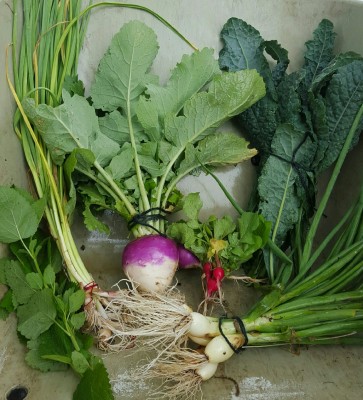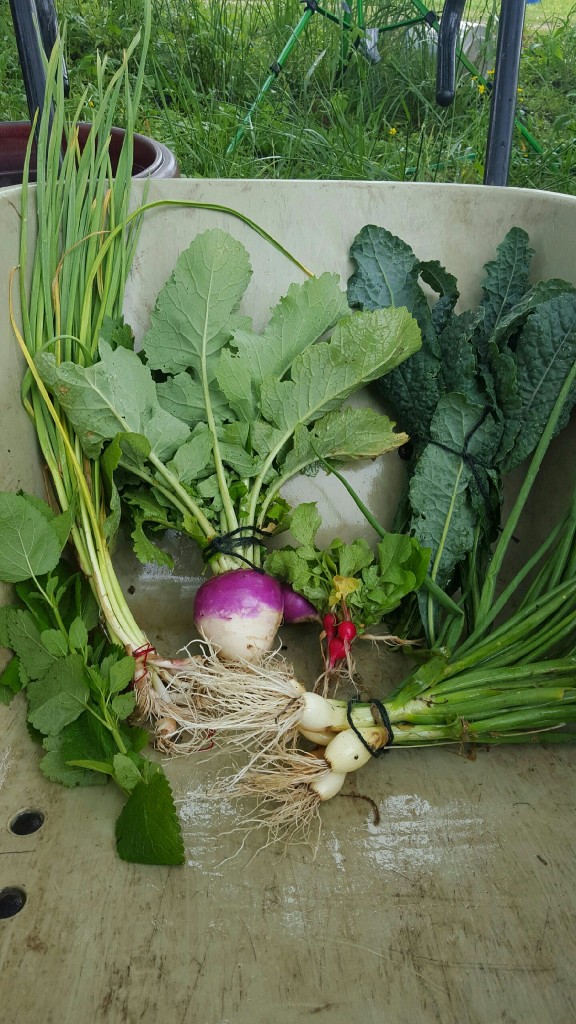Here we go! Welcome to the Spring 2016 CSA. Here at Oak Hill, we love this time of year. The world has exploded in greenery and growth and we’re starting to see the results of planning and hard work that started back at the beginning of the year. Reminder: We wash your veggies each week after harvest, but we always recommend you wash them again, most especially on damp and rainy days like this one.
This week, you have in your boxes:

Turnips: These year-round simple favorites soak up the flavors of anything you cook them with. Boil them on the stove and then mash them with salt and butter, or roast them with a little honey at 400 degrees until tender for a sweeter treat.
For a more adventurous favorite of ours (especially if you’ve done one of our hog shares), try this Chinese Pork and Veggie Hot Pot from Eating Well. For a down-home variant with a little Asian flare, omit the store-bought chili-garlic sauce and anise/aniseed. Instead, saute our spring onion and baby garlic (equal parts white ‘bulb’ and green stem) in a little butter or oil of your choice, sprinkle with just a smattering of salt, and use 2-4 teaspoons of that easy, homemade nomminess in place of the garlic-chili sauce. Add the toasted sesame seeds or omit, depending on availability and personal taste. If you want to add some heat, throw in a little Rooster Sauce (or try it with our hot peppers later in the year!)
Radishes and arugula: There are a million online recipes for salads that use arugula and radishes; we’re partial to this apple, radish, and arugula salad with a tasty vinaigrette. Or keep it simple… chop the radishes and their greens, wash the arugula and remove roots, and add all of it — in moderation — to a lettuce mix for a flavorful and spicy salad. Or get a little goofy… this “eyeballtini” garnished with a radish “eyeball” is a funny weekend treat with friends.
Lacinato Kale: known by other names as black kale, Tuscan kale, cavolo nero, or dinosaur kale. It was once grown for Thomas Jefferson in Monticello’s vegetable gardens, so it’s one of the oldest plant varieties in our garden this year. It is also grown in Italy; it’s a traditional ingredient in the Tuscan soup called ribollita. For more on this fascinating, everything-resistant heirloom kale, check out our blog post on the plant.
Spring Onions: Our yellow spring onions have a tender and delicate flavor. Use the stem as you would a scallion or green onion (they’re basically the same thing, just slightly more mature). Use a spring onion anywhere you’d use a storebought onion, in cooking and grilling or raw on salads. Or, along with the radishes, replace the leeks in this buttered leeks and radishes recipe from Real Simple for a hot, delicious, slightly sweeter take on these traditionally spicier delicacies.
Lemon Balm: Lemon balm is a powerful mint variety with a million uses. Delicious on a sweeter salad or as a garnish in homemade lemonade, it also makes a tea that’s delicious by itself or sweetened with honey–and that’s said to relax like chamomile and to be beneficial for stomach troubles. Bruise a handful of the leaves and drop into a glass or glass jar, cover with boiling water, and steep with a cover on it for 10 minutes so none of the vapors escape. Then drink on its own or sweetened with honey and/or lemon. Thanks to the Nerdy Farm Wife for my favorite post on Lemon Balm, 12 Things to Do With Lemon Balm–go for it! We left the roots on this one so you can plant it if you like; keep it in a pot or somewhere that it can’t overtake other plants, since it grows like crazy and can become invasive.
Baby Garlic: At this tender age, our garlic can be chopped stem and all and used in sautes, stir fries, salads, as garnishes, even in homemade bread recipes for a kick to traditional garlic bread (saute it first!).
Just a reminder: Please keep your bag; we’ll swap a full bag for that empty one next week. You’ll receive two bags as part of your share. We’ll trade out each week, and at the end of the seven weeks, the bags are yours to keep. If you lose one, you can buy a replacement from us for $8 (with or without custom artwork by our 7-year-old artist-in-residence Evie). We’ve implemented this policy because we’ve had trouble getting bags and boxes back from customers in previous years; we hope you understand.
Thank you all for joining us on this springtime journey. See you next week!
To plant a garden is to believe in tomorrow.
–Audrey Hepburn


Love the recipes and uses for lemon balm. My mother grew it for her evening tea with a bit of honey in it. I’ve always grown lemon balm but in my last move the plants didn’t survive. This year I bought a seed packet and I think every seed has come up. The plants are about ready to move to a spot outside. I grow mine in a mostly burried large plastic tote. Same thing for each of my mints. It just helps contain them but holds in moisture as well. I live in high mountain desert. So while it can spread by seed I’ve not had much problem with that. It does help to contain my mints that spread by runner. I often keep pots of my mints in the kitchen window all winter so I can have a bit fresh when I want tea or a garnish. In fall I always dry some of every mint.
Such a wonderful herb! Our daughter has made a “mint drink” from fresh mountain mint that grows by the back door since she was about 4. Warm water, muddle the mint and strain, add honey – she’s made it for everything from tea parties to big batches for family reunions, and our go-to for a sore throat in the fall. We dry it too… or muddle in a little water and freeze in ice cube trays to thaw out in a mug of hot water over the winter!